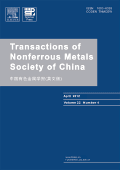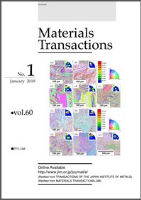
Uspekhi Fiziki Metallov-Progress in Physics of Metals
metrics 2024
Driving Discoveries in Physics of Metals
Introduction
Uspekhi Fiziki Metallov - Progress in Physics of Metals, published by the G V KURDYUMOV INST METAL PHYSICS NAS UKRAINE, is a distinguished open-access journal that has been advancing the field of metal physics since 2000. With an ISSN of 1608-1021 and E-ISSN of 2617-0795, this journal is pivotal for disseminating rigorous research findings and innovations across diverse subfields including Condensed Matter Physics, Electronic, Optical and Magnetic Materials, and Fluid Flow and Transfer Processes. The journal's strong impact, reflected in its Q2 and Q3 quartile rankings across several categories and a commendable Scopus ranking, places it at the forefront of materials science and engineering. Researchers, professionals, and students can benefit from its rich repository of high-quality articles aimed at fostering knowledge and collaboration in metal physics. With an accessible repository and commitment to the open-access model, Progress in Physics of Metals strives to make significant contributions to the global scientific community, shaping the future of metal-based research.
Metrics 2024
 0.42
0.42 1.50
1.50 1.20
1.20 15
15Metrics History
Rank 2024
Scopus
IF (Web Of Science)
JCI (Web Of Science)
Quartile History
Similar Journals

METALLURGICAL AND MATERIALS TRANSACTIONS A-PHYSICAL METALLURGY AND MATERIALS SCIENCE
Advancing the Frontiers of Metallurgy and Materials ScienceMETALLURGICAL AND MATERIALS TRANSACTIONS A - PHYSICAL METALLURGY AND MATERIALS SCIENCE, published by Springer, is a prestigious journal that plays a pivotal role in advancing the fields of physical metallurgy and materials science. With an ISSN of 1073-5623 and an E-ISSN of 1543-1940, this American journal provides a vital platform for disseminating cutting-edge research and innovative findings relevant to condensed matter physics, mechanics of materials, and metals and alloys. The journal, indexed with an impressive Q1 ranking in multiple categories in 2023, ensures its position among the top-tier publications, making it an essential resource for researchers, professionals, and students alike. Spanning decades of invaluable contributions since its inception in 1975, METALLURGICAL AND MATERIALS TRANSACTIONS A focuses on fostering academic dialogue, promoting collaboration, and showcasing leading-edge discoveries that drive the materials science community forward. Researchers seeking to publish their work in a highly visible forum will find this journal an optimal choice for reaching a discerning audience.

ACTA METALLURGICA SINICA
Forging Connections Between Research and ApplicationACTA METALLURGICA SINICA, established in 1978 and published by SCIENCE PRESS, stands as a preeminent journal in the fields of metallurgy and materials science. This journal is particularly revered for its contributions to Metals and Alloys, Mechanical Engineering, Geotechnical Engineering, and Mechanics of Materials, with a commendable Q1 ranking in Metals and Alloys and notable placements in other engineering disciplines. With a robust history of facilitating scholarly communication from 1978 to 1991 and consistently since 1996, the journal provides a vital platform for researchers and practitioners to disseminate significant advancements in material science. Despite being a subscription-based journal, ACTA METALLURGICA SINICA remains pivotal, holding a Scopus ranking that places it in the top tiers of its categories, fostering an environment ripe for innovation and collaboration. This ensures that the journal remains central to the ongoing discussions and developments within the metallurgy community, serving both academic and professional interests.

TETSU TO HAGANE-JOURNAL OF THE IRON AND STEEL INSTITUTE OF JAPAN
Leading the Charge in Iron and Steel AdvancementsTETSU TO HAGANE - JOURNAL OF THE IRON AND STEEL INSTITUTE OF JAPAN is a prominent journal that publishes cutting-edge research in the fields of metallurgy, materials science, and condensed matter physics. Since its inception, this esteemed publication has served as a vital resource for professionals and researchers interested in the advancements in iron and steel technology. Published by the Iron Steel Institute of Japan, this journal has embraced an Open Access model since 2020, facilitating broad dissemination of knowledge to a global audience. The journal showcases significant contributions to materials chemistry and alloys, while consistently ranking in the Q3 and Q4 quartiles across various fields, reflecting its commitment to maintaining rigorous academic standards. Located in the heart of Tokyo, this journal not only highlights research developments in Japan but also fosters international collaboration, making it an indispensable asset for anyone engaged in the study and application of iron and steel.

JOURNAL OF ENGINEERING MATERIALS AND TECHNOLOGY-TRANSACTIONS OF THE ASME
Advancing the frontier of engineering materials and technology.JOURNAL OF ENGINEERING MATERIALS AND TECHNOLOGY-TRANSACTIONS OF THE ASME is a premier journal published by the American Society of Mechanical Engineers (ASME), dedicated to advancing the field of engineering materials and technology. With an ISSN of 0094-4289 and E-ISSN 1528-8889, this journal has provided invaluable insights since its inception in 1973. Operating from its headquarters in New York, United States, it serves a global audience of researchers, professionals, and students alike. The journal is recognized for its rigorous peer-review process and its commitment to disseminating high-quality research, currently holding a Q3 quartile ranking across multiple categories including Condensed Matter Physics, Materials Science, Mechanical Engineering, and Mechanics of Materials. With a focus on exploring innovative materials and their applications, it aims to foster collaboration and discovery in the engineering community. Although it is not an open-access journal, it continues to play a vital role in shaping the future of engineering materials research up to 2024. Researchers and practitioners will find in this journal a significant platform to support the development and understanding of engineering materials, making contributions that resonate through academia and industry.

Metallography Microstructure and Analysis
Pioneering Studies in Metallography and Material PropertiesWelcome to Metallography Microstructure and Analysis, a prominent journal dedicated to the exploration of microstructural properties and their implications in metallic materials. Published by SpringerNature, this journal stands at the forefront of research in the field of materials science, particularly focusing on metals and alloys. With an impressive Q2 ranking in 2023 within its category and a Scopus rank of #72 out of 176, it continues to provide significant contributions to the understanding of metallography, attracting diverse readership among researchers, industry professionals, and students alike. The journal spans a converged period from 2012 to 2024, ensuring it captures the evolving landscape of metallurgical studies. Although it does not currently offer open access, this platform is essential for disseminating high-quality, peer-reviewed research that fosters innovation and development in metallurgical practices.

JOM
Elevating the discourse in materials science.JOM, published by Springer, is a leading academic journal dedicated to advancing research in the fields of Engineering and Materials Science. With an ISSN of 1047-4838 and an E-ISSN of 1543-1851, JOM has established itself as a reputable source of scholarly articles, contributing significantly to the understanding and development of materials and their applications in engineering. As of 2023, it ranks in the second quartile (Q2) in both the Engineering (miscellaneous) and Materials Science (miscellaneous) categories, showcasing its influence and academic rigor. With a Scopus rank of #84 in General Engineering and #212 in General Materials Science, JOM is positioned as a vital resource for academics and professionals aiming to stay abreast of the latest research trends and innovations. Although the journal does not currently offer open access options, its commitment to quality publishing continues to make it an essential read for researchers and students alike, fostering a collaborative environment for growth and discovery in the materials science community.

TRANSACTIONS OF NONFERROUS METALS SOCIETY OF CHINA
Elevating the discourse on materials chemistry and engineering geology.TRANSACTIONS OF NONFERROUS METALS SOCIETY OF CHINA, published by Elsevier, is a premier academic journal that serves as a vital platform for researchers and professionals specializing in materials science, condensed matter physics, geotechnical engineering, and engineering geology. Established in 1994, this esteemed publication has maintained a robust focus on the latest developments in the nonferrous metals sector, reflecting its significant impact in the field with a Q1 categorization across multiple disciplines. With impressive Scopus rankings—placing it in the top 20% of journals in relevant categories—this journal is recognized for its quality and rigor, providing critical insights into metals and alloys, materials chemistry, and their applications. The non-open access format ensures a dedicated readership among professionals and academics seeking substantial and authoritative research articles. By fostering knowledge exchange, the journal strives to advance the understanding and application of nonferrous metals, making it an essential resource for anyone involved in material innovations and engineering solutions.

POWDER METALLURGY AND METAL CERAMICS
Advancing the Frontiers of Materials SciencePOWDER METALLURGY AND METAL CERAMICS is a prestigious journal published by Springer, dedicated to advancing the field of powder metallurgy and the development of metal ceramics. With an ISSN of 1068-1302 and an E-ISSN of 1573-9066, this journal includes significant research contributions that explore innovative developments in materials science and engineering. Since its inception in 1993, it has garnered attention within multiple disciplines, consistently ranking in the Q2 and Q3 quartiles across categories such as Metals and Alloys, Ceramics and Composites, and Mechanics of Materials. The journal offers valuable insights into the synthesis, characterization, and applications of advanced materials, making it an essential platform for researchers, professionals, and students aiming to stay at the forefront of technological advancements in this dynamic field. Although not currently offering open access, the journal remains a critical resource for disseminating high-quality research that influences both academia and industry.

MATERIALS TRANSACTIONS
Your Gateway to Cutting-Edge Materials ResearchMATERIALS TRANSACTIONS, published by the Japan Institute of Metals & Materials, stands as a pivotal journal in the fields of Condensed Matter Physics, Materials Science, and Mechanical Engineering. Operating since 1993, this peer-reviewed journal aims to disseminate high-quality research that advances our understanding of material properties and behaviors under varied conditions. With an ISSN of 1345-9678 and an E-ISSN of 1347-5320, it provides open access options, ensuring that the latest findings are readily available to a global audience. The journal currently holds a commendable Q3 ranking across multiple categories, underscoring its relevance and impact in the respective fields. Located in Sendai, Japan, MATERIALS TRANSACTIONS has emerged as a vital resource for researchers, professionals, and students alike, fostering innovation and collaboration in material science and engineering methodologies. As the demand for advanced materials continues to rise, this journal serves as an essential platform for sharing and discussing cutting-edge research and developments.

Acta Metallurgica Slovaca
Exploring the forefront of metallurgical research and collaboration.Acta Metallurgica Slovaca is a distinguished open-access journal published by SCICELL SRO that has been pivotal in the field of Materials Science and Metallurgy since its inception. With a robust commitment to disseminating high-quality research, this journal covers a wide array of topics within the scope of metals and alloys. Now indexed in Scopus, it ranks 82nd out of 176 in its category, reflecting a growing influence within the scientific community. With a quartile ranking of Q3 as of 2023, Acta Metallurgica Slovaca serves as an essential platform for researchers and professionals seeking to share innovative findings and developments in metallurgical science. Open access since 2013, it ensures that research is accessible to all, fostering collaboration and engagement across academia and industry worldwide. With a converged publication timeline extending from 2009 to 2024, this journal continues to play a crucial role in advancing knowledge and addressing contemporary challenges in the metallurgy sector.